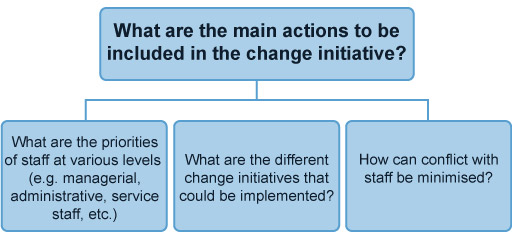9 Further development of your research questions
Before you embark on collecting data for your project, it is necessary to have a clear and specific focus for your research – i.e. the research aim, purpose or question(s). Section 5 gave you some examples of research questions. As a research question does not necessarily need to be expressed as a question (it is called a question because it is a problem to be solved), a study can have one general research aim or question and a few secondary aims or questions. It may also have only one research aim or question. In the case of quantitative studies, a few hypotheses might be developed. These will emerge from gaps in the literature but would have to derive from, and be linked to, an overall research purpose. Section 10 discusses research hypotheses.
The clear development of one or more research questions will guide the development of your data collection process and the tool(s) or instrument(s) you will use. Your research question should emerge from a specific need to acquire greater knowledge about a phenomenon or a situation. Such need may be a personal one as well as a contextual and organisational need. Box 1 gives an example of this.
Box 1 An example of how to develop a research question
As a consequence of government cuts, your arts organisation has to re-structure and this is causing stress and tension among staff. You are involved in the planning of the change initiative and want to develop an organisational change programme that minimises stress and conflict. In order to do so you need to know more about people’s views, at the various organisational levels.
What type of questions would help you to:
- understand the context
- demonstrate to the various research stakeholders (e.g. organisational members and research participants or supervisor, etc.) what you intend to do.
Perhaps you would like to make some notes of your initial ideas and think about how you could apply this process to developing your own research question.
Reading around the topic will help you to achieve greater focus, as will discussing your initial questions with colleagues or supervisor. In the example above, assuming the literature has been searched and several articles on change management and business restructuring have been read, you are likely to have developed clearer ideas about what you want to investigate and how you want to investigate it. Figure 6 shows what the main research question and the sub-questions or objectives might be:

This example is very well developed and would constitute a much larger project than the work-based project you might be doing. However the development of a general question and more specific questions focusing on different aspects should give you an idea of the relationship between the main question and the sub-questions.
In developing your research questions you also need to be concerned with issues of feasibility in terms of access and time. You do not need to be over ambitious but you need to realistically evaluate how difficult it would be to get the data you are planning in the time you have available before submitting the project at the end of the course. You need to plan a project that is neither too broad nor too narrow in scope and one that can be carried out in the available time.
Activity 9
Revisit your research topic and look back at the notes you have made about the topic (including the mind map you developed earlier in the course). Expand and amend where you need to.
Now think about what you need to do to re-write your statement as a research question and write the question in the space provided below.
Write a maximum of four sub-questions or research objectives that will help you to answer the main research question given above. In formulating the sub-questions make sure you consider the scope and the feasibility of the project. Write your questions in the space provided below.
There is no feedback on this activity.
